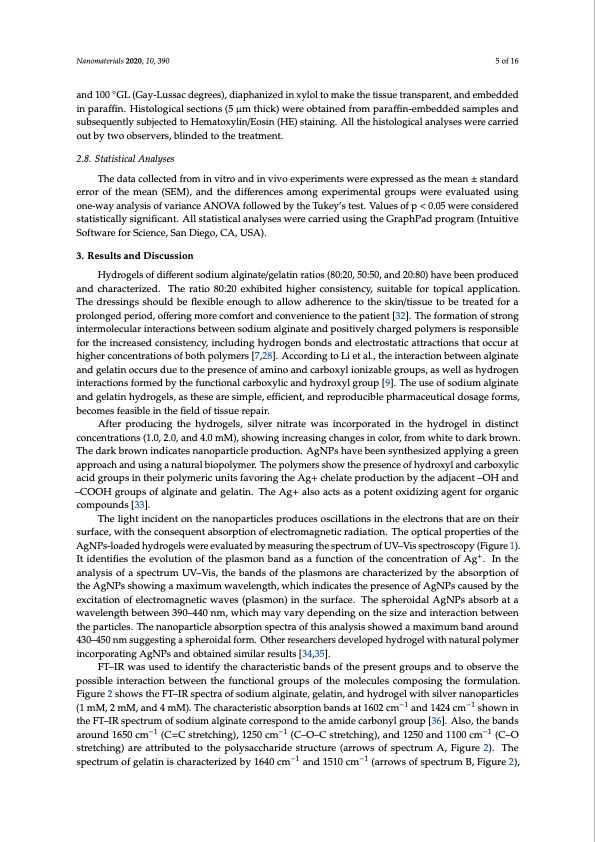
PDF Publication Title:
Text from PDF Page: 005
Nanomaterials 2020, 10, 390 5 of 16 and 100 ◦GL (Gay-Lussac degrees), diaphanized in xylol to make the tissue transparent, and embedded in paraffin. Histological sections (5 μm thick) were obtained from paraffin-embedded samples and subsequently subjected to Hematoxylin/Eosin (HE) staining. All the histological analyses were carried out by two observers, blinded to the treatment. 2.8. Statistical Analyses The data collected from in vitro and in vivo experiments were expressed as the mean ± standard error of the mean (SEM), and the differences among experimental groups were evaluated using one-way analysis of variance ANOVA followed by the Tukey’s test. Values of p < 0.05 were considered statistically significant. All statistical analyses were carried using the GraphPad program (Intuitive Software for Science, San Diego, CA, USA). 3. Results and Discussion Hydrogels of different sodium alginate/gelatin ratios (80:20, 50:50, and 20:80) have been produced and characterized. The ratio 80:20 exhibited higher consistency, suitable for topical application. The dressings should be flexible enough to allow adherence to the skin/tissue to be treated for a prolonged period, offering more comfort and convenience to the patient [32]. The formation of strong intermolecular interactions between sodium alginate and positively charged polymers is responsible for the increased consistency, including hydrogen bonds and electrostatic attractions that occur at higher concentrations of both polymers [7,28]. According to Li et al., the interaction between alginate and gelatin occurs due to the presence of amino and carboxyl ionizable groups, as well as hydrogen interactions formed by the functional carboxylic and hydroxyl group [9]. The use of sodium alginate and gelatin hydrogels, as these are simple, efficient, and reproducible pharmaceutical dosage forms, becomes feasible in the field of tissue repair. After producing the hydrogels, silver nitrate was incorporated in the hydrogel in distinct concentrations (1.0, 2.0, and 4.0 mM), showing increasing changes in color, from white to dark brown. The dark brown indicates nanoparticle production. AgNPs have been synthesized applying a green approach and using a natural biopolymer. The polymers show the presence of hydroxyl and carboxylic acid groups in their polymeric units favoring the Ag+ chelate production by the adjacent –OH and –COOH groups of alginate and gelatin. The Ag+ also acts as a potent oxidizing agent for organic compounds [33]. The light incident on the nanoparticles produces oscillations in the electrons that are on their surface, with the consequent absorption of electromagnetic radiation. The optical properties of the AgNPs-loaded hydrogels were evaluated by measuring the spectrum of UV–Vis spectroscopy (Figure 1). It identifies the evolution of the plasmon band as a function of the concentration of Ag+. In the analysis of a spectrum UV–Vis, the bands of the plasmons are characterized by the absorption of the AgNPs showing a maximum wavelength, which indicates the presence of AgNPs caused by the excitation of electromagnetic waves (plasmon) in the surface. The spheroidal AgNPs absorb at a wavelength between 390–440 nm, which may vary depending on the size and interaction between the particles. The nanoparticle absorption spectra of this analysis showed a maximum band around 430–450 nm suggesting a spheroidal form. Other researchers developed hydrogel with natural polymer incorporating AgNPs and obtained similar results [34,35]. FT–IR was used to identify the characteristic bands of the present groups and to observe the possible interaction between the functional groups of the molecules composing the formulation. Figure 2 shows the FT–IR spectra of sodium alginate, gelatin, and hydrogel with silver nanoparticles (1 mM, 2 mM, and 4 mM). The characteristic absorption bands at 1602 cm−1 and 1424 cm−1 shown in the FT–IR spectrum of sodium alginate correspond to the amide carbonyl group [36]. Also, the bands around 1650 cm−1 (C=C stretching), 1250 cm−1 (C–O–C stretching), and 1250 and 1100 cm−1 (C–O stretching) are attributed to the polysaccharide structure (arrows of spectrum A, Figure 2). The spectrum of gelatin is characterized by 1640 cm−1 and 1510 cm−1 (arrows of spectrum B, Figure 2),PDF Image | Wound Healing Silver Nanoparticles-Composing Hydrogel

PDF Search Title:
Wound Healing Silver Nanoparticles-Composing HydrogelOriginal File Name Searched:
nanomaterials-10-00390-v2.pdfDIY PDF Search: Google It | Yahoo | Bing
Turbine and System Plans CAD CAM: Special for this month, any plans are $10,000 for complete Cad/Cam blueprints. License is for one build. Try before you buy a production license. More Info
Waste Heat Power Technology: Organic Rankine Cycle uses waste heat to make electricity, shaft horsepower and cooling. More Info
All Turbine and System Products: Infinity Turbine ORD systems, turbine generator sets, build plans and more to use your waste heat from 30C to 100C. More Info
CO2 Phase Change Demonstrator: CO2 goes supercritical at 30 C. This is a experimental platform which you can use to demonstrate phase change with low heat. Includes integration area for small CO2 turbine, static generator, and more. This can also be used for a GTL Gas to Liquids experimental platform. More Info
Introducing the Infinity Turbine Products Infinity Turbine develops and builds systems for making power from waste heat. It also is working on innovative strategies for storing, making, and deploying energy. More Info
Need Strategy? Use our Consulting and analyst services Infinity Turbine LLC is pleased to announce its consulting and analyst services. We have worked in the renewable energy industry as a researcher, developing sales and markets, along with may inventions and innovations. More Info
Made in USA with Global Energy Millennial Web Engine These pages were made with the Global Energy Web PDF Engine using Filemaker (Claris) software.
Infinity Turbine Developing Spinning Disc Reactor SDR or Spinning Disc Reactors reduce processing time for liquid production of Silver Nanoparticles.
| CONTACT TEL: 608-238-6001 Email: greg@infinityturbine.com | RSS | AMP |